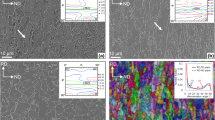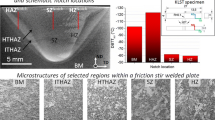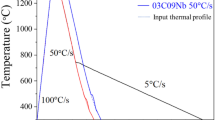Abstract
This work proposes a quantitative relationship between the resistance of hot-rolled steels to brittle cleavage fracture and typical microstructural features, such as microtexture. More specifically, two hot-rolled ferritic pipeline steels were studied using impact toughness and specific quasistatic tensile tests. In drop weight tear tests, both steels exhibited brittle out-of-plane fracture by delamination and by so-called “abnormal” slant fracture, here denoted as “brittle tilted fracture” (BTF). Their sensitivity to cleavage cracking was thoroughly determined in the fully brittle temperature range using round notched bars, according to the local approach to fracture, taking anisotropic plastic flow into account. Despite limited anisotropy in global texture and grain morphology, a strong anisotropy in critical cleavage fracture stress was evidenced for the two steels, and related through a Griffith-inspired approach to the size distribution of clusters of unfavorably oriented ferrite grains (so-called “potential cleavage facets”). It was quantitatively demonstrated that the occurrence of BTF, as well as the sensitivity to delamination by cleavage fracture, is primarily related to an intrinsically high sensitivity of the corresponding planes to cleavage crack propagation across potential cleavage facets.














Similar content being viewed by others
Abbreviations
- BTF:
-
Brittle tilted fracture
- RD:
-
Rolling direction of the steel plate
- TD:
-
Transverse direction of the steel plate
- ND:
-
Normal direction of the steel plate
- \(\theta \)-Plane:
-
Plane tilted by \(40{^{\circ }}\) around RD with respect to the rolling plane, along which BTF propagates
- \(\theta \)-Direction:
-
Normal to the \(\theta \)-plane
- Anti-\(\theta \)-plane:
-
Plane tilted by \(40{^{\circ }}\) around TD with respect to the rolling plane
- Anti-\(\theta \)-direction:
-
Normal to the anti-\(\theta \)-plane
- PCF :
-
Potential cleavage facet, estimated from microtexture analyses
- \(PCF_{eff\_s}^d\) :
-
Effective PCF size normal to the given loading direction d and relative to given steel S
- \(\alpha ^{a,b}\) :
-
Misorientation angle between \(\langle {001}\rangle \) directions of grain a and adjacent grain b that are closest to the loading direction
- \(\alpha _c\) :
-
Critical value of \(\alpha ^{a,b}\) used in the determination of PCFs
- \(\beta ^{a,b}\) :
-
Misorientation angle between adjacent grains a and b
- \(\beta _c\) :
-
Critical value of \(\beta ^{a,b}\) used in the determination of PCFs
- \(\sigma _{c\_s}^d\) :
-
Critical cleavage fracture stress estimated from notched tensile tests along loading direction d of steel S
- \(\sigma _{G\_s}^d\) :
-
Critical cleavage fracture stress estimated from the Griffith-inspired approach along loading direction d of steel S
- a :
-
Exponent coefficient used for the calculation of \({\underline{\sigma }}_{\textit{eq}}\)
- \({\underline{\sigma }}^{\textit{dev}}\) :
-
Modified deviator of the stress tensor \({\underline{\sigma }}\)
- \({\underline{\sigma }}_{\textit{eq}}\) :
-
Equivalent stress of the stress tensor \({\underline{\sigma }}\)
- \(\omega ^{i}\) :
-
Minimum angle between the loading direction and a \(\langle {001}\rangle \) direction of grain i
- \(\omega _c\) :
-
Critical value of \(\omega ^{i}\) used in the determination of PCFs
- \(c^{i}\) :
-
Coefficients of the tensor used for the calculation of \({\underline{\sigma }}^{\textit{dev}}\)
- \(R_0, H,Q,b\) :
-
Hardening parameters of the Voce equation
- \(\sigma _{a}\), \(\sigma _{b}\), \(T_{0}\) :
-
Parameters of the \(R_{0}\) versus temperature dependence equation
References
Andrieu A (2013) Mechanisms and multi-scale modeling of brittle fracture modifications induced by the thermal ageing of a pressurised water reactor steel. Ph.D. dissertation, MINES ParisTech, France, 2013, in French. https://pastel.archives-ouvertes.fr/pastel-00957868. Accessed on 14 Nov 2017
ANSI/API (1996) RP 5L3 standard, recommended practice for conducting drop-weight tear tests on line pipe. American Petroleum Institute, Washington, 1996
Baldi G, Buzzichelli G (1978) Critical stress for delamination fracture in HSLA steels. Met Sci 12:459–472. https://doi.org/10.1179/030634578790433332
Barlat F, Lege D, Brem B (1991) A six-component yield function for anisotropic materials. Int J Plast 7:693–712. https://doi.org/10.1016/0749-6419(91)90052-Z
Beremin FM (1983) A local criterion for cleavage fracture of a nuclear pressure vessel steel. Metall Trans 14A:2277–2287. https://doi.org/10.1007/BF02663302
Besson J, Foerch R (1997) Large scale object-oriented finite element code design. Comput Methods Appl Mech Eng 142:165–187. https://doi.org/10.1016/S0045-7825(96)01124-3
Besson J, Cailletaud G, Chaboche J-L, Forest S (2009) Nonlinear mechanics of materials. Springer, Dordrecht ISBN -13: 978-9048133550
Bourell DL (1983) Cleavage delamination in impact tested warm-rolled steel. Metall Trans 14A:2487–2496. https://doi.org/10.1007/BF02668890
Bouyne E, Flower HM, Lindley TC, Pineau A (1998) Use of EBSD to examine microstructure and cracking in a bainitic steel. Scr Mater 39:295–300. https://doi.org/10.1016/S1359-6462(98)00170-5
Bowen P, Druce SG, Knott JF (1986) Effects of microstructure on cleavage fracture in pressure vessel steel. Acta Metall 34:1121–1131. https://doi.org/10.1016/0001-6160(86)90222-1
Brozzo P, Buzzichelli G, Mascanzoni A, Mirabile M (1977) Microstructure and cleavage resistance of low-carbon bainitic steels. Met Sci 11:123–130. https://doi.org/10.1179/msc.1977.11.4.123
Cosham A, Jones DG, Eiber R, Hopkins P (2009) Don’t drop the drop weight tear test. In: Denys R (ed) Pipeline technology conference, 12–14 Oct 2009, Ostend, Belgium, paper no. Ostend2009-090
Di Shino A, Guarnaschelli C (2010) Microstructure and cleavage resistance of high strength steels. Mater Sci Forum 638–642:3188–3193. https://doi.org/10.4028/www.scientific.net/MSF.638-642.3188
EN (2013) EN10208 standard (replaced by NF EN ISO 3183 standard issued in March, 2013), petroleum and natural gas industries—steel pipe for pipeline transportation systems. International Organization for Standardization (ISO), Geneva, Switzerland
Fujishiro T, Hara T (2011) Effect of separation on ductile crack propagation behavior during drop weight tear test. In: Chung JS, Hong SY, Langen I, Prinsenberg SJ (eds) Proceedings of the twenty-first international offshore and polar engineering conference. The International Society of Offshore and Polar Engineers (ISOPE), Cupertino, pp 237–242
Gell M, Smith E (1967) The propagation of cracks through grain boundaries in polycrystalline 3% silicon–iron. Acta Metall 15:253–258. https://doi.org/10.1016/0001-6160(67)90200-3
Gervasyev A, Carretero Olalla V, Pyshmintsev I, Struin A, Arabey A, Petrov RH, Kestens LAI (2013) X-80 pipeline steel characteristics defining the resistance to ductile fracture propagation. In: Denys R (ed) Sixth international pipeline technology conference, October 2013, Ostend, Belgium, Soete Laboratory, Gent, Belgium. ISBN: 9780957531024, paper number S19-02. http://hdl.handle.net/1854/LU-5866094
Gervasyev A, Carretero Olalla V, Sidor J, Sanchez Mouriño N, Kestens LAI, Petrov RH (2016a) An approach to microstructure quantification in terms of impact properties of HSLA pipeline steels. Mater Sci Eng A677:163–170. https://doi.org/10.1016/j.msea.2016.09.043
Gervasyev A, Petrov R, Pyshmintsev I, Struin A, Leis B (2016b) Mechanical properties anisotropy in X80 line pipes. In: International pipeline conference, vol 3, September 2016, Calgary, Canada. ISBN: 978-0-7918-5027-5, paper number IPC2016-64695. https://doi.org/10.1115/IPC2016-64695
Ghosh A, Modak P, Dutta R, Chakrabarti D (2016a) Effect of MnS inclusion and crystallographic texture on anisotropy in Charpy impact toughness of low carbon ferritic steel. Mater Sci Eng A654:298–308. https://doi.org/10.1016/j.msea.2015.12.047
Ghosh A, Patra S, Chatterjee A, Chakrabarti D (2016b) Effect of local crystallographic texture on the fissure formation during Charpy impact testing of low-carbon steel. Metall Mater Trans 47A:2755–2772. https://doi.org/10.1007/s11661-016-3458-y
Gourgues AF, Flower HM, Lindley TC (2000) Electron backscattering diffraction study of acicular ferrite, bainite and martensite steel microstructures. Mater Sci Technol 16:26–40. https://doi.org/10.1179/026708300773002636
Hara T, Shinohara Y, Asahi H, Terada Y (2006) Effects of microstructure and texture on DWTT properties for high strength line pipe steels. In: Proceedings of ASME international pipeline conference, vol 3, September 2006, Calgary, Canada, pp 245–250. ISBN: 0-7918-4263-0, https://doi.org/10.1115/IPC2006-10255
Hara T, Shinohara Y, Terada Y, Asahi H (2008) DWTT properties for high strength line pipe steels. In: Jin HW, Wang Y-Y and Lillig DB (eds) Proceedings of the eighteenth international offshore and polar engineering conference, Vancouver, BC, Canada, July 2008. The International Society of Offshore and Polar Engineers (ISOPE), Cupertino, pp 189–193
Hill R (1950) The mathematical theory of plasticity. Clarendon Press, Oxford
Hong S, Shin SY, Lee S, Kim NJ (2011) Effects of specimen thickness and notch shape on fracture modes in the drop weight tear test of API X70 and X80 linepipe steels. Metall Mater Trans 42A:2619–2632. https://doi.org/10.1007/s11661-011-0697-9
Hwang B, Lee S, Kim YM, Kim NJ, Yoo JW, Woo CS (2004) Analysis of abnormal fracture occurring during drop-weight tear test of high-toughness line-pipe steel. Mater Sci Eng A368:18–27. https://doi.org/10.1016/j.msea.2003.09.075
Joo MS, Suh D-W, Bae JH, Bhadeshia HKDH (2012) Role of delamination and crystallography on anisotropy of Charpy toughness in API-X80 steel. Mater Sci Eng A546:314–322. https://doi.org/10.1016/j.msea.2012.03.079
Kotrechko S, Stetsenko N, Shevchenko S (2004) Effect of texture smearing on the anisotropy of cleavage-stress of metals and alloys. Theor Appl Fract Mech 42:89–98. https://doi.org/10.1016/j.tafmec.2004.06.007
Lambert-Perlade A, Gourgues AF, Besson J, Sturel T, Pineau A (2004) Mechanisms and modeling of cleavage fracture in simulated heat-affected zone microstructures of a high-strength low alloy steel. Metall Mater Trans 35A:1039–1053. https://doi.org/10.1007/s11661-004-1007-6
León García O, Petrov R, Bae J-H, Kestens L, Kang KB (2007) Microstructure-texture related toughness anisotropy of API-X80 pipeline steel. Adv Mater Res 15–17:240–245. https://doi.org/10.4028/www.scientific.net/AMR.15-17.840
Lu W, Chen J, Chakravarthula SS, Qiao Y (2010) Resistance to cleavage cracking and subsequent shearing of high-angle grain boundary. Eng Fract Mech 77:768–775. https://doi.org/10.1016/j.engfracmech.2009.12.009
Lu W, Chen J, Kong X, Chakravarthula SS, Qiao Y (2011) Nonuniform cleavage cracking across persistent grain boundary. Mech Mater 43:567–573. https://doi.org/10.1016/j.mechmat.2011.07.001
McRobie DE, Knott JF (1985) Effects of strain and strain aging on fracture toughness of C–Mn weld metal. Mater Sci Technol 1:357–365. https://doi.org/10.1179/mst.1985.1.5.357
Mintz B, Morrison WB (2007) Influence of fissures on tensile and fracture toughness of steels with ferrite/pearlite microstructures. Mater Sci Technol 23:1346–1356. https://doi.org/10.1179/174328407X168801
Pineau A (2015) Crossing grain boundaries in metals by slip bands, cleavage and fatigue cracks. Philos Trans R Soc Lond Ser A 373(2014):0131. https://doi.org/10.1098/rsta.2014.0131
Punch R, Strangwood M, Davis C (2012) Origin and propagation of splits in high-strength low-alloy strip steel. Metall Mater Trans 43A:4622–4632. https://doi.org/10.1007/s11661-012-1307-1
Qiao Y, Argon AS (2003) Cleavage cracking resistance of high angle grain boundaries in Fe–3%Si alloy. Mech Mater 35:313–331. https://doi.org/10.1016/S0167-6636(02)00284-3
Ritchie RO, Knott JF, Rice JR (1973) On the relationship between critical tensile stress and fracture and toughness in mild steel. J Mech Phys Solids 21:395–410. https://doi.org/10.1016/0022-5096(73)90008-2
Rosenfield AR, Shetty DK, Skidmore AJ (1983) Fractographic observations of cleavage initiation in the ductile-brittle transition region of a reactor-pressure-vessel steel. Metall Trans 14A:1934–1937. https://doi.org/10.1007/BF02645567
Sanchez Mouriño N, Petrov R, Bae J-H, Kim K, Kestens LAI (2010) Texture dependent mechanical anisotropy of X890 pipeline steel. Adv Eng Mater 12:973–980. https://doi.org/10.1002/adem.201000065
Schofield R, Rowntree G, Sarma NV, Weiner RT (1974) ‘Arrowhead’ fractures in controlled-rolled pipeline steels. Met Technol 1:325–331. https://doi.org/10.1179/030716974803288112
Stec M, Faleskog J (2009) Micromechanical modeling of grain boundary resistance to cleavage crack propagation in ferritic steels. Int J Fract 160:151–167. https://doi.org/10.1007/s10704-009-9415-7
Sun J, Boyd JD (2000) Effect of thermomechanical processing on anisotropy of cleavage fracture stress in microalloyed linepipe steel. Int J Press Vessel Pip 77:369–377. https://doi.org/10.1016/S0308-0161(00)00038-7
Sung HK, Sohn SS, Shina SY, Lee S, Kim NJ, Chon SH, Yoo JY (2012) Effects of finish rolling temperature on inverse fracture occurring during drop weight tear test of API X80 pipeline steels. Mater Sci Eng A541:181–189. https://doi.org/10.1016/j.msea.2012.02.019
Tankoua F (2015) Ductile to brittle transition in pipeline steels: quantitative investigation of brittle out-of-plane cracking and correlation to microtexture anisotropy. Ph.D. dissertation, MINES ParisTech, France, 2015 (in English). https://pastel.archives-ouvertes.fr/tel-01212488. Accessed on 14 Nov 2017
Tankoua F, Crépin J, Thibaux P, Arafin M, Cooreman S, Gourgues A-F (2014a) Delamination of pipeline steels: determination of an anisotropic cleavage criterion. Mech Ind 15:45–50. https://doi.org/10.1051/meca/2014001
Tankoua F, Crépin J, Thibaux P, Cooreman S, Gourgues A-F (2014b) Quantitative investigation of brittle out-of-plane fracture in X70 pipeline steels. Proced Mater Eng 3:1149–1154. https://doi.org/10.1016/j.mspro.2014.06.187
Wilkowski GM, Maxey WA, Eiber RJ (1980) Use of the DWTT energy for predicting ductile fracture behavior in controlled-rolled steel pipes. Can Metall Q 10:59–77. https://doi.org/10.1179/cmq.1980.19.1.59
Yang Z, Kim C-B, Feng Y, Cho C (2008) Abnormal fracture appearance in drop-weight tear test specimens of pipeline steel. Mater Sci Eng A483–484:239–241. https://doi.org/10.1016/j.msea.2006.09.182
Zong C, Zhu G, Mao W (2013) Effect of crystallographic texture on the anisotropy of Charpy impact behavior in pipeline steel. Mater Sci Eng A563:1–7. https://doi.org/10.1016/j.msea.2012.11.055
Acknowledgements
Financial support from the French Agency for Research and Technology (ANRT) under CIFRE Grant No. 2011/1199 is gratefully acknowledged. Fruitful discussions with Dr M. Mazière (MINES ParisTech) and technical help from A. Laurent and A. Meddour (MINES ParisTech) and from Frank Rootsaert, Martin Liebeherr, Andries De Geest and Nuria Sanchez (OCAS) are gratefully acknowledged.
Author information
Authors and Affiliations
Corresponding author
Ethics declarations
Conflict of interest
The authors declare that they have no conflict of interest.
Additional information
Publisher's Note
Springer Nature remains neutral with regard to jurisdictional claims in published maps and institutional affiliations.
Appendix: Determination of the tilt and twist components of a cleavage crack deviation to cross a cleavage facet boundary
Appendix: Determination of the tilt and twist components of a cleavage crack deviation to cross a cleavage facet boundary
Let us consider a first facet with normal \({{\varvec{n}}}_{\mathbf{1}}\) that has been created by a cleavage crack. The local orientation of the facet boundary is b. Let us consider that the closest possible crack propagation plane in the adjacent grain has normal \({{\varvec{n}}}_{\mathbf{2}}\). In the general case, b is neither parallel (pure tilt) nor perpendicular (pure twist) to the cross-product \({{\varvec{n}}}_{\mathbf{1}} \times {{\varvec{n}}}_{\mathbf{2}}\). The situation is illustrated in Fig. 14. The orientation of facets 1 and 2 is schematized on both sides of the facet boundary, to better illustrate the calculation procedure.
Let \({{\varvec{p}}} = {{\varvec{n}}}_{\mathbf{1}} \times {{\varvec{b}}}\) be the direction belonging to facet 1 and perpendicular to boundary b. The tilt component is calculated in the auxiliary plane \(P_{\textit{tilt}}\), containing both p and \({{\varvec{n}}}_{\mathbf{1}}\) (its normal is direction b). It is the angle between the so-called ti direction (belonging to both \(P_{\textit{tilt}}\) and cleavage facet 2: \({{\varvec{ti}}} = {{\varvec{n}}}_{\mathbf{2}} \times {{\varvec{b}}}\)) and direction p. Mathematically, it is expressed as follows:
The twist component is calculated in the auxiliary plane \(P_{\textit{twist}}\), containing both b and \({{\varvec{n}}}_{\mathbf{1}}\) (its normal is direction p). Let tw be the direction common to both plane \(P_{\textit{twist}}\) and facet 2, i.e., \({{\varvec{tw}}} = {{\varvec{p}}} \times {{\varvec{n}}}_{\mathbf{2}}\), which can be rewritten as \({{\varvec{tw}}} = ({{\varvec{n}}}_{\mathbf{1}} \times {{\varvec{b}}}) \times {{\varvec{n}}}_{\mathbf{2}}\). The twist component is the angle between tw and direction b, mathematically expressed as:
The values of tilt and twist components measured from quantitative fractography data are reported in Fig. 9 of the main text.
Rights and permissions
About this article
Cite this article
Tankoua, F., Crépin, J., Thibaux, P. et al. Quantification and microstructural origin of the anisotropic nature of the sensitivity to brittle cleavage fracture propagation for hot-rolled pipeline steels. Int J Fract 212, 143–166 (2018). https://doi.org/10.1007/s10704-018-0297-4
Received:
Accepted:
Published:
Issue Date:
DOI: https://doi.org/10.1007/s10704-018-0297-4




